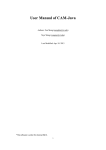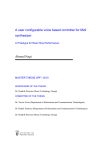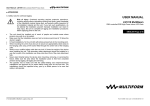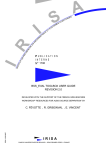Download BSS Oracle Toolbox Version 2.1 User Guide
Transcript
BSS Oracle Toolbox Version 2.1 User Guide Emmanuel Vincent R´emi Gribonval Mark D. Plumbley October 12, 2007 2 Contents 1 Getting started 1.1 Download and install . 1.2 Software dependencies 1.3 Getting help . . . . . . 1.4 Citation . . . . . . . . 1.5 Licenses . . . . . . . . . . . . . 5 5 5 5 6 6 2 Content 2.1 Reference publications . . . . . . . . . . . . . . . . . . . . . . . . . . . . . . . . . 2.2 Principle . . . . . . . . . . . . . . . . . . . . . . . . . . . . . . . . . . . . . . . . . 2.3 Summary of the content . . . . . . . . . . . . . . . . . . . . . . . . . . . . . . . . 7 7 7 7 . . . . . . . . . . . . . . . . . . . . . . . . . 3 Reference manual 3.1 General notations . . . . . . . . 3.2 Oracle source estimators . . . . bss oracle multifilt . . . . bss oracle monomask . . . . . bss oracle binmask . . . . . . bss oracle pinvmask . . . . . bss oracle bbasis monomask . bss oracle bbasis binmask . bss oracle bbasis pinvmask . bss oracle gbasis monomask . 3.3 Near-optimal source estimators bss nearopt multifilt . . . . bss nearopt monomask . . . . bss nearopt binmask . . . . . bss nearopt pinvmask . . . . 3.4 Time-frequency transforms . . mdct . . . . . . . . . . . . . . . imdct . . . . . . . . . . . . . . stft . . . . . . . . . . . . . . . istft . . . . . . . . . . . . . . 3.5 Filtering and masking functions apply multifilt temp . . . . apply multifilt freq . . . . apply pinvmask inst . . . . . apply pinvmask conv . . . . . 3.6 Auxiliary functions . . . . . . . . . . . . . . . . . . . . . . . . . . . . . . . . . . . . . . . . . . . . . . . . . . . . . . . . . . . . . . . . . . . . . . . . . . . . . . . . . . . . . . . . . . . . . . . . . . . . . . . . . . . . . . . . . . . . . . . . . . . . . . . . . . . 3 . . . . . . . . . . . . . . . . . . . . . . . . . . . . . . . . . . . . . . . . . . . . . . . . . . . . . . . . . . . . . . . . . . . . . . . . . . . . . . . . . . . . . . . . . . . . . . . . . . . . . . . . . . . . . . . . . . . . . . . . . . . . . . . . . . . . . . . . . . . . . . . . . . . . . . . . . . . . . . . . . . . . . . . . . . . . . . . . . . . . . . . . . . . . . . . . . . . . . . . . . . . . . . . . . . . . . . . . . . . . . . . . . . . . . . . . . . . . . . . . . . . . . . . . . . . . . . . . . . . . . . . . . . . . . . . . . . . . . . . . . . . . . . . . . . . . . . . . . . . . . . . . . . . . . . . . . . . . . . . . . . . . . . . . . . . . . . . . . . . . . . . . . . . . . . . . . . . . . . . . . . . . . . . . . . . . . . . . . . . . . . . . . . . . . . . . . . . . . . . . . . . . . . . . . . . . . . . . . . . . . . . . . . . . . . . . . . . . . . . . . . . . . . . . . . . . . . . . . . . . . . . . . . . . . . . . . . . . . . . . . . . . . . . . . . . . . . . . . . . . . . . . . . . . . . . . . . . . . . . . . . . . . . . . . . . . . . . . . . . . . . . . . . . . . . . . . . . . . . . . . . . . . . . . . . . . . . . . . . . . . . . . . . . . . . . . . . . . . . . . . . . . . . . . . . . . . . . . . . . . . . . . . . . . . . . . . . . . . . . . . . . . . . . . . . . . . . . . . . . . . . . . . . . . . . . . . . . . . . . . . . . . . . . . . . . . . . . . . . . . . . . . . . . . . . . . . . . . . . . . . . . . . . . . . . . . . . . . . . . 9 9 10 10 11 12 13 14 15 16 17 18 18 19 20 21 22 22 23 24 25 26 26 27 28 29 30 4 CONTENTS optim coeffs . . . . . . . . . . . . . . . . . . . . . . . . . . . . . . . . . . . . . . pinv filt . . . . . . . . . . . . . . . . . . . . . . . . . . . . . . . . . . . . . . . . sdr . . . . . . . . . . . . . . . . . . . . . . . . . . . . . . . . . . . . . . . . . . . . 30 31 32 4 Example data and applications 4.1 Sources and filters . . . . . . . . . . . . . . . . . . . . . . . . . . . . . . . . . . . 4.2 Scripts . . . . . . . . . . . . . . . . . . . . . . . . . . . . . . . . . . . . . . . . . . 33 33 33 Bibliography 35 Chapter 1 Getting started 1.1 Download and install Two versions of the BSS Oracle toolbox are available. R The basic version of the toolbox, which includes the main Matlab1 programs and this user guide, can be downloaded at http://bass-db.gforge.inria.fr/bss oracle/bss oracle basic.zip After unzipping this file, you should get a directory called bss oracle 2.1. To install, simply R path using the command pathtool. add the full path to this directory to your Matlab R The full version of the toolbox, which includes additional example data and Matlab programs, can be downloaded at http://bass-db.gforge.inria.fr/bss oracle/bss oracle full.zip After unzipping this file, you should get in addition to the main directory called bss oracle 2.1 two sub-directories called examples and data. To install, simply add the full paths to the main R path. directory and to the sub-directories to your Matlab 1.2 Software dependencies R R BSS Oracle consists in a set of Matlab functions, and as such needs Matlab to run. Some functions of BSS Oracle (involving MDCT, CP or WP transforms) also depend on the Wavelab toolbox version 802 by D. Donoho, M.R. Duncan, X. Huo and O. Levi, available at http://www-stat.stanford.edu/~wavelab/ Follow the provided documentation for install instructions. Note that Wavelab is copyrighted and cannot be redistributed together with BSS Oracle. 1.3 Getting help R Within Matlab , you can get basic help about the toolbox by typing help bss oracle 2.1 1 R is a registered trademark of The MathWorks, Inc. Matlab 5 6 1.4 CHAPTER 1. GETTING STARTED Citation If you use the BSS Oracle toolbox in a work that you wish to publish, please cite it as: E. Vincent, R. Gribonval and M.D. Plumbley. BSS Oracle Toolbox Version 2.1. http://bass-db.gforge.inria.fr/bss oracle/ 1.5 Licenses The files contained in the BSS Oracle toolbox are distributed under different licenses. Therefore it is crucial that you understand which license applies to each file before attempting to redistribute or modify some files. The files contained in the main directory bss oracle 2.1 and in the subdirectory examples are distributed under the terms of the GNU General Public License (GPL) version 2. A copy of the GPL is distributed along with the toolbox in the file LICENSE.txt. The music sound files contained in the subdirectory data are distributed under specific Creative Commons licenses. For more details about the license applying to each file, see the file data/LICENSES.txt. All other files of the subdirectory data are license free. Chapter 2 Content The purpose of the BSS Oracle toolbox is to compute the best performance achievable by a class of source separation algorithms in an evaluation framework where target signals are known. It does not provide any blind source separation method. 2.1 Reference publications The mathematical details underlying the toolbox are described in [3, 1, 2]. 2.2 Principle Let us suppose that we observe a mixture signal x(t) from which we want to extract a set of source signals y(t). Within a given class of source separation algorithms, the estimated signal b (t) can always be expressed under the form y b = f (x, θ) y with θ ∈ Θ, (2.1) where f is a fixed parametric function, θ a vector of separation parameters and Θ a set of acceptable parameters. Different algorithms correspond to different ways of estimating θ. Assuming that the target signal y(t) is known, the separation performance of a given algorithm can be evaluated using the Euclidean distortion measure d(b y, y) = kb y − yk2 . (2.2) The oracle estimator of the target signal is then defined by e x, Θ)), e (y, x, Θ) = f (x, θ(y, y (2.3) e x, Θ) is the set of parameters resulting in the smallest distortion among the set of where θ(y, acceptable parameters Θ: e x, Θ) = arg min d(f (x, θ), y). θ(y, (2.4) θ∈Θ 2.3 Summary of the content The basic version of the toolbox implements oracle source estimators for four classes of algorithms: multichannel time-invariant filtering, single-channel time-frequency masking, multichannel time-frequency masking and best basis masking. In some cases, the exact oracle estimators 7 8 CHAPTER 2. CONTENT cannot be computed due to high memory and/or computational time requirements. Thus nearoptimal source estimators are implemented instead. The full version of the toolbox also contains example data and routines that were used to create the figures of the reference publications. Chapter 3 Reference manual 3.1 T I J L M K General notations length of the signals in samples number of channels of the mixture signal number of source or target signals length of the demixing filters, or MDCT/STFT length stepsize between successive STFT windows number of mixture signals (for generic oracle bases) 9 10 3.2 CHAPTER 3. REFERENCE MANUAL Oracle source estimators bss oracle multifilt Oracle estimator for source separation by multichannel time-invariant filtering in the time domain. Syntax: [Se,W,SDR]=bss oracle multifilt(X,S,L) Inputs: X S L I × T matrix containing the multichannel mixture signal J × T matrix containing the target signals (e.g. sources or source images) length of the demixing filters in samples Outputs: Se W SDR J × T matrix containing the oracle estimates of the target signals (truncated to the same time range as the original signals) J × I × L table containing the coefficients of the oracle demixing filters (delays from − L2 + 1 to L2 ) achieved SDR in deciBels (before truncation of the target estimates) Reference: See [3] Section 4.2. 3.2. ORACLE SOURCE ESTIMATORS 11 bss oracle monomask Oracle estimator for single-channel source separation by time-frequency masking using MDCT with sine window. Syntax: [Se,W,SDR]=bss oracle monomask(x,S,L) [Se,W,SDR]=bss oracle monomask(x,S,L,mreal) [Se,W,SDR]=bss oracle monomask(x,S,L,mreal,mconst) Inputs: x S L mreal mconst 1 × T vector containing the single-channel mixture signal J × T matrix containing the target signals (e.g. source images) length of the MDCT window in samples (must be a multiple of 4) true for real-valued masking (default), false for binary masking true when the masks are subject to a unitary sum constraint (default), false otherwise Outputs: Se W SDR J × T matrix containing the oracle estimates of the target signals (truncated to the same time range as the original signals) 2T L 2 × N × J table containing the oracle masks with N = ceil L achieved SDR in deciBels (before truncation of the target estimates) Reference: See [3] Section 5.2. 12 CHAPTER 3. REFERENCE MANUAL bss oracle binmask Oracle estimator for multichannel source separation by constrained binary time-frequency masking using MDCT with sine window. Syntax: [Se,W,SDR]=bss oracle binmask(X,S,L) Inputs: X S L I × T matrix containing the multichannel mixture signal I × T × J table containing the target signals (source images) length of the MDCT window in samples (must be a multiple of 4) Outputs: Se W SDR I × T × J table containing the oracle estimates of the target signals (truncated to the same time range as the original signals) 2T L 2 × N × J table containing the oracle masks with N = ceil L achieved SDR in deciBels (before truncation of the target estimates) Reference: See [3] Section 6.2. 3.2. ORACLE SOURCE ESTIMATORS 13 bss oracle pinvmask Oracle estimator for multichannel source separation of instantaneous mixtures by time-frequency masking and mixing matrix pseudo-inversion using MDCT with sine window. Syntax: [Se,W,SDR]=bss oracle pinvmask(X,S,L,A) [Se,W,SDR]=bss oracle pinvmask(X,S,L,A,Ja) Inputs: X S L A Ja I × T matrix containing the multichannel mixture signal I × T × J table containing the target signals (source images) length of the MDCT window in samples (must be a multiple of 4) I × J real-valued mixing matrix (may be different from the one actually used to generate S) number of active sources per time-frequency point (by default or if Ja = 0, the best number is estimated for each time-frequency point) Outputs: Se W SDR I × T × J table containing the oracle estimates of the target signals (truncated to the same time range as the original signals) L 2 × N × J table of binary coefficients indicating the oracle source activity 2T patterns with N = ceil L achieved SDR in deciBels (before truncation of the target estimates) Reference: See [3] Section 6.2. 14 CHAPTER 3. REFERENCE MANUAL bss oracle bbasis monomask Oracle estimator for single-channel source separation by time-frequency masking using the best CP/WP basis. Syntax: [Se,btree,W,SDR,stree]=bss [Se,btree,W,SDR,stree]=bss [Se,btree,W,SDR,stree]=bss [Se,btree,W,SDR,stree]=bss oracle oracle oracle oracle bbasis bbasis bbasis bbasis monomask(x,S,Dmin,Dmax) monomask(x,S,Dmin,Dmax,pcos) monomask(x,S,Dmin,Dmax,pcos,mreal) monomask(x,S,Dmin,Dmax,pcos,mreal,mconst) Inputs: x S Dmin Dmax pcos mreal mconst 1 × T vector containing the single-channel mixture signal J × T matrix containing the target signals (e.g. source images) minimal packet depth maximal packet depth true for CP basis with sine window (default), false for WP basis with symmlet-8 true for real-valued masking (default), false for binary masking true when the masks are subject to a unitary sum constraint (default), false otherwise Outputs: Se btree W SDR stree J × T matrix containing the oracle estimates of the target signals (truncated to the same time range as the original signals) 1 × (2Dmax +1 − 1) vector of binary values representing the tree structure corresponding to the oracle best basis 2N × (Dmax − Dmin + 1) × J table containing the oracle masking coefficients for each scale with N = nextpow2(T ) achieved SDR in deciBels (before truncation of the target estimates) 1 × (2Dmax +1 − 1) vector containing the oracle distortion for all basis elements (infinite for disallowed scales) Reference: See [2] Section 7.2. 3.2. ORACLE SOURCE ESTIMATORS 15 bss oracle bbasis binmask Oracle estimator for multichannel source separation by constrained binary time-frequency masking using the best CP/WP basis. Syntax: [Se,btree,W,SDR,stree]=bss oracle bbasis binmask(X,S,Dmin,Dmax) [Se,btree,W,SDR,stree]=bss oracle bbasis binmask(X,S,Dmin,Dmax,pcos) Inputs: X S Dmin Dmax pcos I × T matrix containing the multichannel mixture signal J × T matrix containing the target signals (source images) minimal packet depth maximal packet depth true for CP basis with sine window (default), false for WP basis with symmlet-8 Outputs: Se btree W SDR stree Reference: See [1]. J × T matrix containing the oracle estimates of the target signals (truncated to the same time range as the original signals) 1 × (2Dmax +1 − 1) vector of binary values representing the tree structure corresponding to the oracle best basis 2N × (Dmax − Dmin + 1) × J table containing the oracle masking coefficients for each scale with N = nextpow2(T ) achieved SDR in deciBels (before truncation of the target estimates) 1 × (2Dmax +1 − 1) vector containing the oracle distortion for all basis elements (infinite for disallowed scales) 16 CHAPTER 3. REFERENCE MANUAL bss oracle bbasis pinvmask Oracle estimator for multichannel source separation of instantaneous mixtures by time-frequency masking and mixing matrix pseudo-inversion using the best CP/WP basis. Syntax: [Se,btree,W,SDR,stree]=bss oracle bbasis pinvmask(X,S,A,Dmin,Dmax) [Se,btree,W,SDR,stree]=bss oracle bbasis pinvmask(X,S,A,Dmin,Dmax,Ja) [Se,btree,W,SDR,stree]=bss oracle bbasis pinvmask(X,S,A,Dmin,Dmax,Ja,pcos) Inputs: X S A Dmin Dmax Ja pcos I × T matrix containing the multichannel mixture signal J × T matrix containing the target signals (source images) I × J real-valued mixing matrix (may be different from the one actually used to generate S) minimal packet depth maximal packet depth number of active sources per time-frequency point (by default or if Ja = 0, the best number is estimated for each time-frequency point) true for CP basis with sine window (default), false for WP basis with symmlet-8 Outputs: Se btree W SDR stree J × T matrix containing the oracle estimates of the target signals (truncated to the same time range as the original signals) 1 × (2Dmax +1 − 1) vector of binary values representing the tree structure corresponding to the oracle best basis 2N × (Dmax − Dmin + 1) × J table containing the oracle masking coefficients for each scale with N = nextpow2(T ) achieved SDR in deciBels (before truncation of the target estimates) 1 × (2Dmax +1 − 1) vector containing the oracle distortion for all basis elements (infinite for disallowed scales) Reference: See [1] Section 3.2. 17 3.2. ORACLE SOURCE ESTIMATORS bss oracle gbasis monomask Oracle estimator for single-channel source separation of several mixtures by time-frequency masking using the best generic CP/WP basis. Syntax: [Se,btree,SDR,gSDR,stree]=bss [Se,btree,SDR,gSDR,stree]=bss [Se,btree,SDR,gSDR,stree]=bss [Se,btree,SDR,gSDR,stree]=bss oracle oracle oracle oracle gbasis gbasis gbasis gbasis monomask(x,S,Dmin,Dmax) monomask(x,S,Dmin,Dmax,pcos) monomask(x,S,Dmin,Dmax,pcos,mreal) monomask(x,S,Dmin,Dmax,pcos,mreal,mconst) Warnings: Despite the default setting, this function is mostly relevant for WP bases. Due to huge memory requirements, the optimal masks are not output. The function stores temporary data in a temporary directory defined by the variable tmpdir (default is /tmp/). Inputs: x S Dmin Dmax pcos mreal mconst 1 × T × K table containing K single-channel mixture signals J × T × K table containing K sets of target signals (e.g. source images) minimal packet depth maximal packet depth true for CP basis with sine window (default), false for WP basis with symmlet-8 true for real-valued masking (default), false for binary masking true when the masks are subject to a unitary sum constraint (default), false otherwise Outputs: Se btree SDR gSDR stree J × T × K table containing the oracle estimates of the target signals (truncated to the same time range as the original signals) 1 × (2Dmax +1 − 1) vector of binary values representing the tree structure corresponding to the oracle best generic basis K × 1 vector containing the achieved SDR in deciBels for each mixture (before truncation of the target estimates) total SDR for all mixtures 1 × (2Dmax +1 − 1) vector containing the oracle distortion for all basis elements (infinite for disallowed scales) Reference: See [2] Section 7.3.2. 18 3.3 CHAPTER 3. REFERENCE MANUAL Near-optimal source estimators bss nearopt multifilt Near-optimal demixing matrices for source separation by frequency-domain multichannel timeinvariant filtering using STFT with sine window (coefficients derived for each frequency bin separately). Syntax: [Se,W,SDR]=bss nearopt multifilt(X,S,L) [Se,W,SDR]=bss nearopt multifilt(X,S,L,M) Inputs: X S L M I × T matrix containing the multichannel mixture signal J × T matrix containing the target signals (e.g. sources or source images) length of the STFT window in samples (must be a multiple of 4) step between successive windows in samples (must be a multiple of 2, a divider of L and smaller than L2 ) (default: L2 ) Outputs: Se W SDR J × T matrix containing the near-optimal estimates of the target signals (truncated to the same time range as the original signals) J × I × L2 + 1 table containing near-optimal demixing matrices for positive frequencies achieved SDR in deciBels (before truncation of the target estimates) Reference: See [3] Section 4.4. 3.3. NEAR-OPTIMAL SOURCE ESTIMATORS 19 bss nearopt monomask Near-optimal time-frequency masks for single-channel source separation using STFT with sine window (coefficients derived for each time-frequency point separately). Syntax: [Se,W,SDR]=bss [Se,W,SDR]=bss [Se,W,SDR]=bss [Se,W,SDR]=bss nearopt nearopt nearopt nearopt monomask(x,S,L) monomask(x,S,L,M) monomask(x,S,L,M,mreal) monomask(x,S,L,M,mreal,mconst) Inputs: x S L M mreal mconst 1 × T vector containing the single-channel mixture signal J × T matrix containing the target signals (e.g. source images) length of the STFT window in samples (must be a multiple of 4) step between successive windows in samples (must be a multiple of 2, a divider of L and smaller than L2 ) (default: L2 ) true for real-valued masking (default), false for binary masking true when the masks are subject to a unitary sum constraint (default), false otherwise Outputs: Se W SDR J × T matrix containing the near-optimal estimates of the target signals (truncated to the same time range as the original signals) T L + 1 × N × J table containing near-optimal masks with N = ceil 2 M achieved SDR in deciBels (before truncation of the target estimates) Reference: See [3] Section 5.4. 20 CHAPTER 3. REFERENCE MANUAL bss nearopt binmask Near-optimal constrained binary time-frequency masks for multichannel source separation using STFT with sine window (coefficients derived for each time-frequency point separately). Syntax: [Se,W,SDR]=bss nearopt binmask(X,S,L) [Se,W,SDR]=bss nearopt binmask(X,S,L,M) Inputs: X S L M I × T matrix containing the multichannel mixture signal I × T × J table containing the target signals (source images) length of the STFT window in samples (must be a multiple of 4) step between successive windows in samples (must be a multiple of 2, a divider of L and smaller than L2 ) (default: L2 ) Outputs: Se W SDR I × T × J table containing the near-optimal estimates of the target signals (truncated to the same time range as the original signals) L T + 1 × N × J table containing near-optimal masks with N = ceil 2 M achieved SDR in deciBels (before truncation of the target estimates) Reference: See [3] Section 6.4. 3.3. NEAR-OPTIMAL SOURCE ESTIMATORS 21 bss nearopt pinvmask Near-optimal estimator for multichannel source separation of possibly convolutive mixtures by time-frequency masking and mixing matrix pseudo-inversion using STFT with sine window (activity patterns derived for each time-frequency point separately). Syntax: [Se,W,SDR]=bss nearopt pinvmask(X,S,A) [Se,W,SDR]=bss nearopt pinvmask(X,S,A,Ja) [Se,W,SDR]=bss nearopt pinvmask(X,S,A,Ja,M) Inputs: X S A Ja M I × T matrix containing the multichannel mixture signal I × T × J table containing the target signals (source images) L I×J× 2 + 1 table containing complex mixing matrices for positive frequencies (may be different from the ones actually used to generate S), with L being the length of the STFT window in samples number of active sources per time-frequency point (by default or if Ja = 0, the best number is estimated for each time-frequency point) step between successive windows in samples (must be a multiple of 2, a divider of L and smaller than L2 ) (default: L2 ) Outputs: Se W SDR I × T × J table containing the near-optimal estimates of the target signals (truncated to the same time range as the original signals) L + 1 × N × J table of binary coefficients indicating the oracle source activity 2 T patterns with N = ceil M achieved SDR in deciBels (before truncation of the target estimates) Reference: See [3] Section 6.4. 22 3.4 CHAPTER 3. REFERENCE MANUAL Time-frequency transforms mdct Modified Discrete Cosine Transform using a sine window. Syntax: X=mdct(x,L) Inputs: x L 1 × T vector containing a single-channel signal length of the MDCT window in samples (must be a multiple of 4) Output: X L 2 × N matrix containing the MDCT coefficients with N = ceil 2T L 3.4. TIME-FREQUENCY TRANSFORMS imdct Inverse Modified Discrete Cosine Transform using a sine window. Syntax: x=imdct(X) Input: X L 2 × N matrix containing a set of MDCT coefficients Outputs: x 1× NL 2 vector containing the inverse MDCT signal If x is a signal of length T, X=mdct(x,L) and y=imdct(X), then x=y(1:T). 23 24 CHAPTER 3. REFERENCE MANUAL stft Short-Term Fourier Transform using a sine window. Syntax: X=stft(x,L) X=stft(x,L,M) Inputs: x L M 1 × T vector containing a single-channel signal length of the STFT window in samples (must be a multiple of 4) step between successive windows in samples (must be a multiple of 2, a divider of L and smaller than L2 ) (default: L2 ) Output: X + 1 × N matrix containing the STFT coefficients for positive frequencies T with N = ceil M L 2 3.4. TIME-FREQUENCY TRANSFORMS 25 istft Inverse Short-Term Fourier Transform using a sine window. Syntax: x=istft(X) x=istft(X,M) Inputs: X M + 1 ×N matrix containing a set of STFT coefficients for positive frequencies step between successive windows in samples (must be a multiple of 2, a divider of L and smaller than L2 ) (default: L2 ) L 2 Output: x 1 × N M vector containing the inverse STFT signal If x is a signal of length T, X=stft(x,L) and y=istft(X), then x=y(1:T). 26 3.5 CHAPTER 3. REFERENCE MANUAL Filtering and masking functions apply multifilt temp Apply time-domain demixing filters. Syntax: Se=apply multifilt temp(X,W) Inputs: X W I × T matrix containing the multichannel mixture signal J × I × L table containing the coefficients of the demixing filters (delays from − L2 + 1 to L2 ) Output: Se J × (T + L − 1) matrix containing the demixed signals Reference: See [3] Section 4.1. 27 3.5. FILTERING AND MASKING FUNCTIONS apply multifilt freq Apply frequency-domain demixing matrices using STFT with sine window. Syntax: Se=apply multifilt freq(X,W) Se=apply multifilt freq(X,W,M) Inputs: X W M I × T matrix containing the multichannel mixture signal J × I × L2 + 1 table containing complex demixing matrices for positive frequencies, with L being the length of the STFT window in samples step between successive windows in samples (must be a multiple of 2, a divider of L and smaller than L2 ) (default: L2 ) Output: Se J × N M matrix containing the demixed signals with N = ceil Reference: See [3] Section 4.4. T M 28 CHAPTER 3. REFERENCE MANUAL apply pinvmask inst Apply multichannel time-frequency masks with mixing matrix pseudo-inversion using MDCT with sine window. Syntax: Se=apply pinvmask inst(X,A,W) Inputs: X A W I × T matrix containing the multichannel mixture signal I × J real-valued mixing matrix L 2 × N × J table of binary coefficients indicating the source activity patterns with L being the length of the MDCT window in samples and N = ceil 2T L Output: Se J× NL 2 Reference: See [3] Section 6.1.2. × J table containing the derived source images 3.5. FILTERING AND MASKING FUNCTIONS 29 apply pinvmask conv Apply multichannel time-frequency masks with mixing matrix pseudo-inversion using STFT with sine window. Syntax: Se=apply pinvmask conv(X,A,W) Se=apply pinvmask conv(X,A,W,M) Inputs: X A W M I × T matrix containing the multichannel mixture signal L I × J × 2 + 1 table containing complex mixing matrices for positive frequencies, with L being the length of the STFT window in samples L of binary coefficients indicating the source activity patterns 2 × N × J table with N = ceil 2T L step between successive windows in samples (must be a multiple of 2, a divider of L and smaller than L2 ) (default: L2 ) Output: Se J × N M × J table containing the derived source images Reference: See [3] Section 6.4. 30 3.6 CHAPTER 3. REFERENCE MANUAL Auxiliary functions optim coeffs Oracle constrained real-valued masking coefficients for a single basis element. Syntax: [wo,disto]=optim coeffs(r) Input: r J × 1 vector containing ratios between MDCT, CP or WP coefficients or real parts of ratios between STFT coefficients of the targets and the mixture for a single basis element Outputs: wo disto oracle masking coefficients for this basis element achieved distortion Reference: See [3] Section 5.2. 3.6. AUXILIARY FUNCTIONS 31 pinv filt Pseudo-inversion of a filter system. Syntax: [W,B,SIR]=pinv filt(A,zdel,L) Inputs: A zdel L I ×J ×T table containing filters of length T (delays from −zdel +1 to T −zdel) sample index corresponding to zero delay length of the pseudo-inverse filters in samples Outputs: W B SIR J × I × L table containing pseudo-inverse filters (delays from − L2 + 1 to L2 ) J × J × (T + L − 1) product of W and A (delays from −zdel − L2 + 2 to T − zdel + L2 ) achieved SIR in deciBels Reference: See [2] Section 4.3.3. 32 CHAPTER 3. REFERENCE MANUAL sdr Signal to Distortion Ratio. Syntax: SDR=sdr(Se,S) Inputs: Se S J × T matrix containing the estimated signals J × T matrix containing the target signals Output: SDR achieved SDR in deciBels Reference: See [3] Section 2.3. Chapter 4 Example data and applications The full version of BSS Oracle contains example sources, filters and scripts that were used to plot the figures of the reference publications. 4.1 Sources and filters data/mixk sj.wav data/ir t.mat data/ir move1 250ms.mat data/ir move2 250ms.mat data/ir move3 250ms.mat source j of mixture k, with 1 ≤ j ≤ 3 (music for 1 ≤ k ≤ 10, speech for 11 ≤ k ≤ 20) mixing impulse responses with reverberation time t equal to anechoic, 50ms, 250ms or 1.25s with source 1 at -40◦ mixing impulse responses with 250 ms reverberation time with source 1 at -38◦ mixing impulse responses with 250 ms reverberation time with source 1 at -36◦ mixing impulse responses with 250 ms reverberation time with source 1 at -32◦ See [3] Section 3. 4.2 Scripts multifilt1.m multifilt2.m multifilt3.m multifilt4.m monomask1.m monomask2.m monomask3.m multimask1.m multimask2.m bbasis monomask1.m bbasis monomask2.m bbasis monomask3.m robust1.m robust2.m plots plots plots plots plots plots plots plots plots plots plots plots plots plots figure 2 of [3] figure 3 of [3] figure 4 of [2] figure 4 of [3] figure 5 of [3] figure 7 of [2] figure 6 of [3] figure 7 of [3] figure 8 of [3] figure 11 of [2] figure 12 of [2] figures 13 and 14 of [2] figure 9 of [3] figure 10 of [3] 33 34 CHAPTER 4. EXAMPLE DATA AND APPLICATIONS Bibliography [1] E. Vincent and R. Gribonval. Blind criterion and oracle bound for instantaneous audio source separation using adaptive time-frequency representations. In Proc. IEEE Workshop on Applications of Signal Processing to Audio and Acoustics (WASPAA), 2007. [2] E. Vincent, R. Gribonval, and M.D. Plumbley. Oracle estimators for the benchmarking of source separation algorithms. Technical Report C4DM-TR-06-03, Queen Mary, University of London, 2006. [3] E. Vincent, R. Gribonval, and M.D. Plumbley. Oracle estimators for the benchmarking of source separation algorithms. Signal Processing, 87(8):1933–1950, 2007. 35













































